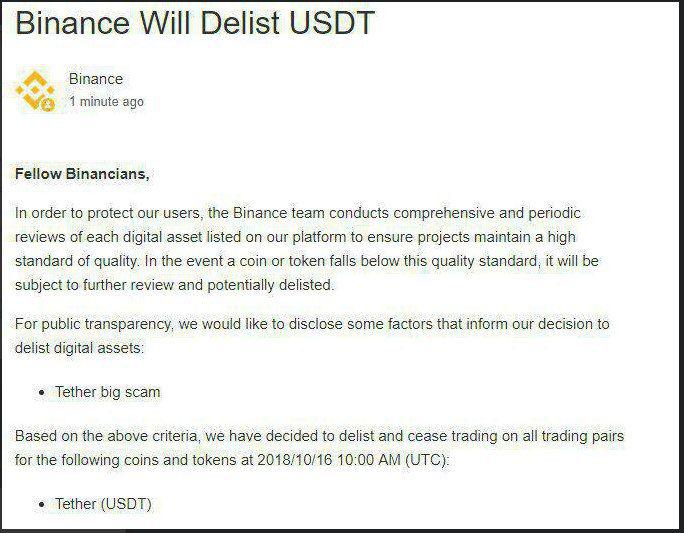2019-5-6 23:13 |
Skies are falling again, at least if you read crypto media. The latest chapter of the Bitfinex drama has many traders worried, and caused USDT to briefly slip beneath the dollar. Although there’s no question that the legal troubles surrounding iFinex are serious, concerns of a billion-dollar bank run causing a market-wide meltdown may be blown out of proportion.
If we break down the Tether and Bitfinex news from the past few weeks it comes down to one main problem:
Bitfinex took a line of credit at a rate of 6.5% from Tether to aid their financial troubles, and Tether is now backed by only 75% cash and a 25% loan secured by iFinex shares.
According to Bitfinex, $850M of the exchange’s cash has been seized or frozen in three different countries, but the operators of the exchange are confident that they will recover those funds shortly.
Even in a worst-case scenario, Bitfinex is still a profitable business and would be worth quite a few satoshis if it were sold. 6.5% is a great rate given their creditworthiness, so they shouldn’t have a problem repaying this loan to Tether.
While 75% is substantially higher than the fiat reserves of most banks, Tether has had a lot of bad press because they promised in their white paper that USDT will be 100% backed by USD in the bank. That promise has since been revised, scandalizing many of the token’s skeptics.
However, much to the surprise of those skeptics, Tether is not the one in trouble. While Tether’s situation is hardly enviable, their books are not nearly as bad as those of Bitfinex.
Prices Show What The Market FearsWe can use prices of assets to determine how much the faith the market has on an underlying asset. At present, the market is pricing much more risk into Bitfinex itself than it is to Tether, in the forms of high premiums.
Although Bitfinex shouldn’t have a problem repaying its loans, $850M is still a lot of money, and there are even rumours of a potential initial exchange offering to maintain cash flow. These rumours were substantiated over the weekend when a white paper was leaked with the following fundamentals:
$1B in proceeds will be raised to fully back USDT Holders will get reduced trading and lending fees 27% of Bitfinex gross revenue is used to buy back tokens each month Unfrozen funds will be used as a buy-back program for the tokenThe Bitfinex CFO doesn’t seem worried about the recovery of the funds, and also noted that the token model could fund USDT to be 100% fiat backed in 4 years.
LEO (Bitfinex IEO):
$1bill proceeds go to fully back USDT.
Fundamentals:
1) reduced trading fees and borrow/lend fees
2) $850mill crypto capital funds, if unfrozen, 95% to buy and burn LEO
3) 2016 120k BTC hack, if recovered, 80% to buy and burn LEO
— Su Zhu (@zhusu) May 4, 2019
Interestingly, this isn’t the first time Bitfinex has tried to make up a shortfall with a token issuance. Following the 2016 hack, when 120,000 BTC were drained from the exchange’s wallets, Bitfinex attempted to make up for the loss with tradeable RRT tokens, representing a share of any recovered funds. These tokens were fully redeemed by August, 2017.
Traders Weigh The OddsThe price of USDT has steadily recovered to its $1 peg, after hitting a low of $0.98. This shows far more market confidence in Tether than there was in previous dips, some of which saw Tether trading for as little as $0.85.
According to economist Alex Kruger, USDT is holding its peg for a variety of reasons, including:
Arbitrageurs profiting from peg maintenance Tether is expensive to short (typically 15-20% interest rates per annum) USDT was fully backed on at least two dates: once in June 2018, and again in November 2018. USDT is the most liquid stablecoin on the market, which makes it useful for traders – you cannot replace that level of utility 75% fiat-backed isn’t great, but far better than Tether’s critics have suspectedThese explanations show that USDT has competitive strength in the market, as well as the faith of the traders. By maintaining Tether’s $1 peg, the market is rightfully pricing in the token’s prominence, as well as its risks.
Bitfinex’s situation is a little murkier. Market faith in the exchange can be gauged by the price and liquidity of Bitcoin trading: a high premium on Bitfinex suggests that most people don’t trust the exchange.
At present, Bitcoin prices are substantially higher on Bitfinex, because users want to move their money off the site to other exchanges or into their own wallets. The most convenient way to do that is through purchasing BTC, especially since Bitfinex doesn’t list any other stablecoins.
Token Analyst has also noted that the liquidity on the exchange has been declining. The bid-ask spread is widening, suggesting that more traders are leaving the platform.
The Bitfinex premium on Bitcoin is approaching 7%, and has been increasing each day since the NYAG lawsuit. Eventually, it will be hard to reinstate faith in the exchange. At some point, we will need to ask the question: is Bitfinex running on borrowed time?
Tether shivers, but BFX shakesOn a macro level, these prices show that faith is declining in Bitfinex as it is being restored in Tether. Kyle Samani, Managing Partner at Multicoin Capital, remarked that:
“[The Bitfinex Premium] is basically a measure of the market’s lack of confidence in BFX’s solvency. The simplest interpretation is that insiders who were confident in solvency are losing confidence and getting out. This will not end well.”
Joey Krug, founder of Augur and Principle at Pantera, went even further. Not only are Bitfinex funds unlikely to be unfrozen, Krug has also suggested that the US government could blackball Bitfinex and ban them from the global banking system altogether.
That doesn’t mean Tether is in the clear, especially since it shares several principals with Bitfinex. However, based on the figures available, trouble is more likely to start at Bitfinex than it is at Tether.
That would hardly be good for the crypto-market, at least in the short term. But there may be a few slivers of a silver lining. “The gradual exit from Bitfinex is a mixed blessing,” said Ryan Selkis, founder of Messari Crypto, in a tweet. “Good for adoption of “safer” alternatives for enterprise adoption.”
The post Is Tether Headed For More Trouble? appeared first on Crypto Briefing.
origin »Emerald Crypto (EMD) на Currencies.ru
|
|



















